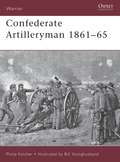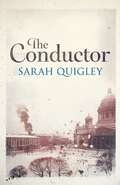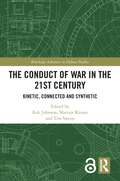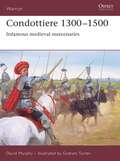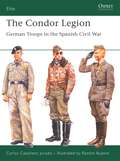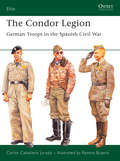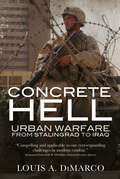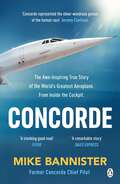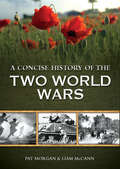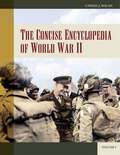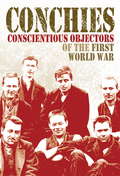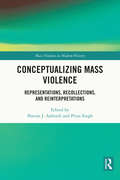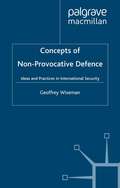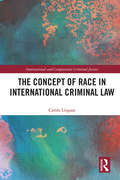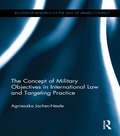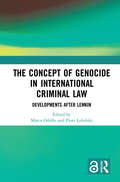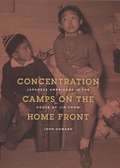- Table View
- List View
Confederate Artilleryman 1861–65 (Warrior #34)
by Bill Younghusband Philip KatcherIn the heady days of the rush to arms in 1861, comparatively few Southern men volunteered for service in the artillery: most preferred the easily accessible glory of the infantry or cavalry. Yet those that did quickly earned the respect of their fellow soldiers, and a reputation for being able to "pull through deeper mud, ford deeper springs, shoot faster, swear louder ... than any other class of men in the service". Given that field artillery was invariably deployed in front of the troops that it was supporting, the artillerymen were exposed to a high level of enemy fire, and losses were significant. This title guides the reader through the life and experiences of the Confederate cannoneer where he came from; how he trained and lived; how he dressed, ate and was equipped; and how he fought.
The Conductor
by Sarah QuigleyThe Conductor reads like a proper up-all-night page-turner, but it also goes deeper than that, conveying the extraordinary life-saving properties of music, and hope' – Bella Bathurst.The story of how Shostakovich and one valiant orchestra created a defining moment in the siege of Leningrad is a gripping testament to the life saving power of music. June 1941: Nazi troops surround the city of Leningrad, planning to shell and starve the people into submission. Most of the cultural elite is evacuated, but the famous composer Shostakovich stays behind to defend his city. That winter, the bleakest in Russian history, the Party orders Karl Eliasberg, the shy, difficult conductor of a second-rate orchestra, to prepare for the task of a lifetime. He is to conduct a performance of Shostakovich's Seventh Symphony – a haunting, defiant new piece, which will be relayed by loudspeakers to the front lines. Eliasberg's musicians are starving, and scarcely have the strength to carry their instruments. But for five freezing months the conductor stubbornly drives on his musicians, depriving those who falter of their bread rations. Slowly the music begins to dissolve the nagging hunger, the exploding streets, the slow deaths... but at what cost? Eliasberg's relationships are strained, obsession takes hold, and his orchestra is growing weaker. Now, it's a struggle not just to perform but to stay alive.
The Conduct of War in the 21st Century: Kinetic, Connected and Synthetic (Routledge Advances in Defence Studies)
by Rob Johnson Tim Sweijs Martijn KitzenThis book examines the key dimensions of 21st century war, and shows that orthodox thinking about war, particularly what it is and how it is fought, needs to be updated. Accelerating societal, economic, political and technological change affects how we prepare, equip and organise for war, as well as how we conduct war – both in its low-tech and high-tech forms, and whether it is with high intensity or low intensity. The volume examines changes in warfare by investigating the key features of the conduct of war during the first decades of the 21st century. Conceptually centred around the terms ‘kinetic’, ‘connected’ and ‘synthetic’, the analysis delves into a wide range of topics. The contributions discuss hybrid warfare, cyber and influence activities, machine learning and artificial intelligence, the use of armed drones and air power, the implications of the counterinsurgency experiences in Iraq, Afghanistan and Syria, as well as the consequences for law(fare) and decision making. This work will be of much interest to students of military and strategic studies, security studies and International Relations.
The Conduct of War in the 21st Century: Kinetic, Connected and Synthetic (Routledge Advances in Defence Studies)
by Rob Johnson, Martijn Kitzen and Tim SweijsThis book examines the key dimensions of 21st century war, and shows that orthodox thinking about war, particularly what it is and how it is fought, needs to be updated. Accelerating societal, economic, political and technological change affects how we prepare, equip and organise for war, as well as how we conduct war – both in its low-tech and high-tech forms, and whether it is with high intensity or low intensity. The volume examines changes in warfare by investigating the key features of the conduct of war during the first decades of the 21st century. Conceptually centred around the terms ‘kinetic’, ‘connected’ and ‘synthetic’, the analysis delves into a wide range of topics. The contributions discuss hybrid warfare, cyber and influence activities, machine learning and artificial intelligence, the use of armed drones and air power, the implications of the counterinsurgency experiences in Iraq, Afghanistan and Syria, as well as the consequences for law(fare) and decision making. This work will be of much interest to students of military and strategic studies, security studies and International Relations.
Condottiere 1300–1500: Infamous medieval mercenaries (Warrior)
by David MurphyOriginally contracted by wealthy Italian city states to protect their assets during a time of ceaseless warring, many condottieri of the Italian peninsula became famous for their wealth, venality and amorality during the 14th and 15th centuries. Some even came to rule cities themselves. Lavishly illustrated with contemporary depictions and original artwork, this title examines the complex military organization, recruitment, training and weaponry of the Condottieri. With insight into their origins and motivations, the author, Dr David Murphy, brings together the social, political and military history of these powerful and unscrupulous men who managed to influence Italian society and warfare for over two centuries.
Condottiere 1300–1500: Infamous medieval mercenaries (Warrior)
by David MurphyOriginally contracted by wealthy Italian city states to protect their assets during a time of ceaseless warring, many condottieri of the Italian peninsula became famous for their wealth, venality and amorality during the 14th and 15th centuries. Some even came to rule cities themselves. Lavishly illustrated with contemporary depictions and original artwork, this title examines the complex military organization, recruitment, training and weaponry of the Condottieri. With insight into their origins and motivations, the author, Dr David Murphy, brings together the social, political and military history of these powerful and unscrupulous men who managed to influence Italian society and warfare for over two centuries.
The Condor Legion: German Troops in the Spanish Civil War (Elite #131)
by Ramiro Bujeiro Carlos Caballero JuradoThe Condor Legion was the expeditionary force of soldiers and airmen sent by Hitler to aid Franco's Nationalists in the Spanish Civil War. The Germans used the war as an opportunity to develop equipment and tactics, and their force included not only instructors, but also combat units of artillery, tanks and aircraft. These units tested guns, tanks and planes and perfected techniques which were used in the 1940 Blitzkrieg. Many of officers prominent in the early campaigns of World War II won their first successes in Spain. This book details the Legion and its unique uniform and insignia.
The Condor Legion: German Troops in the Spanish Civil War (Elite #131)
by Ramiro Bujeiro Carlos Caballero JuradoThe Condor Legion was the expeditionary force of soldiers and airmen sent by Hitler to aid Franco's Nationalists in the Spanish Civil War. The Germans used the war as an opportunity to develop equipment and tactics, and their force included not only instructors, but also combat units of artillery, tanks and aircraft. These units tested guns, tanks and planes and perfected techniques which were used in the 1940 Blitzkrieg. Many of officers prominent in the early campaigns of World War II won their first successes in Spain. This book details the Legion and its unique uniform and insignia.
Concrete Hell: Urban Warfare From Stalingrad to Iraq
by Louis A. DiMarcoThroughout history cities have been at the center of warfare, from sieges to street-fighting, from peace-keeping to coups de mains. Sun Tzu admonished his readers of The Art of War that the lowest realization of warfare was to attack a fortified city. Indeed, although strategists have advised against it across the millennia, armies and generals have been forced nonetheless to attack and defend cities, and victory has required that they do it well. In Concrete Hell Louis DiMarco has provided a masterful study of the brutal realities of urban warfare, of what it means to seize and hold a city literally block by block. Such a study could not be more timely. We live in an increasingly urbanizing world, a military unprepared for urban operations is unprepared for tomorrow. Di Marco masterfully studies the successes and failures of past battles in order to provide lessons for today's tacticians.
Concrete Hell: Urban Warfare From Stalingrad to Iraq (General Military Ser.)
by Louis A. DiMarcoThroughout history cities have been at the center of warfare, from sieges to street-fighting, from peace-keeping to coups de mains. Sun Tzu admonished his readers of The Art of War that the lowest realization of warfare was to attack a fortified city. Indeed, although strategists have advised against it across the millennia, armies and generals have been forced nonetheless to attack and defend cities, and victory has required that they do it well. In Concrete Hell Louis DiMarco has provided a masterful study of the brutal realities of urban warfare, of what it means to seize and hold a city literally block by block. Such a study could not be more timely. We live in an increasingly urbanizing world, a military unprepared for urban operations is unprepared for tomorrow. Di Marco masterfully studies the successes and failures of past battles in order to provide lessons for today's tacticians.
Concorde: The thrilling account of history’s most extraordinary airliner
by Mike BannisterThe definitive account of the rise and fall of the iconic Concorde plane from British Airways' former Chief Concorde Pilot'A remarkable story' DAILY EXPRESS'A stonking good read' FLYER_________What's it like to fly faster than a bullet?Could you really glimpse the edge of space?Why will we never see Concorde's like again?Mike Bannister was British Airways' Chief Concorde Pilot. One of the few in that legendary aircraft's quarter-century of flight to fully understand both the plane's intricate engineering and what it took to fly her at supersonic speeds.In this definitive account of the rise and fall of the world's greatest aircraft, Bannister explores its origins, development, service, highs, lows and, finally, the terrible crash which ended its flying life.Part celebration, part history, part detective story and part courtroom drama, it's almost as riveting as flying in Concorde itself - almost . . ._________'Concorde represented the sheer wondrous genius of the human race' JEREMY CLARKSON
A Concise History of Two World Wars
by Pat Morgan Liam McCannThis new ebook combines both concise histories of WWI and WWII in one book, written by Pat Morgan and Liam McCann respectively.WWIOn 28 June 1914 in Sarajevo, a Bosnian Serb student shot the heir to the throne of the Austro-Hungarian Empire. The assassination plunged the world into a global conflict that was to scar human history and redefine the meaning of the word ‘war’.The assassination of Archduke Franz Ferdinand provided the spark that ignited smouldering enmities, but World War I had been a long time coming. Decades of burgeoning imperialism and the formation of complex alliances brought the world’s great powers face to face in what would become known as the Great War.On one side were ranged the Allies of Great Britain, France and Russia; on the other the Central Powers of Germany and Austria-Hungary. As time went on and the killing continued, all the world’s powers were drawn into battle and the war’s deadly influence touched every corner of the planet.More than seventy million military personnel were mobilised during World War I – and more than nine million of them died. The grim figures also included twenty million wounded and eight million missing in action.When the war ended in 1918, four empires had ceased to exist, the map of Europe had been redrawn and a generation of young men had been lost. The combatants had given their all, but their valiant sacrifice was in vain. This book tells the story of the conflict dubbed ‘the war to end wars’.WWIIBy 1938 a second war in Europe seemed inevitable. It had only been twenty years since the war to end all wars, and the horrors of conflict were still fresh in the mind, but that didn’t stop all sides re-arming and preparing for yet more bloodshed.The settlement at the end of World War One was neither clean nor decisive, and it punished Germany by confiscating territory and forcing the people to pay reparations to help rebuild France and reduce the Allied debt to America. This led to deep-seated anger and resentment among its people.This erudite and moving book explores the underlying causes of the Second World War, its biggest battles and decisive campaigns. From the evacuation at Dunkirk, the Blitz and the Battle of Britain to the failure of Operation Barbarossa and the D-Day Landings in Europe, as well as the war in North Africa and the Pacific, this concise history of the conflict also examines the Final Solution and the ethics surrounding the dropping of two atom bombs on Japan.
The Concise Encyclopedia of World War II [2 volumes]: [2 volumes]
by Cathal J. NolanA comprehensive and integrated military, political, and strategic history of World War II, ranging from the daily life of conscripts and civilians to operational and strategic decision making at the highest levels.Filled with up-to-date scholarship yet supremely manageable and accessible, The Concise Encyclopedia of World War II offers the opportunity to explore a conflict that remains a source of fascination for scholars, students, and general readers alike.From the battlefields to the corridors of power, from the barracks to the home front, The Concise Encyclopedia of World War II provides a complete portrait of the war. Entries not only address major battles and campaigns, but political, economic, and cultural issues as well, plus brief portraits of the conflict's commanding personalities. Its global perspective notably corrects the usual Western focus of World War II studies, incorporating a wealth of information on often underreported topics such as the Eastern Front and the Sino-Japanese War.
Conchies: Conscientious Objectors Of The First World War (One Shot Ser.)
by Ann KramerWhen, at the height of the First World War, many Allied governments introduced conscription, there were thousands of individuals who, for personal or religious reasons, refused to fight. After tough questioning, some were exempted but the majority were forced into the army anyways. Those who 'refused to do their duty' were threatened with death sentences or harsh prison terms; many died from ill treatment. Conchies collects many of the moving true stories of these brave individuals.
Conceptualizing Mass Violence: Representations, Recollections, and Reinterpretations (Mass Violence in Modern History)
by Navras J. Aafreedi Priya SinghConceptualizing Mass Violence draws attention to the conspicuous inability to inhibit mass violence in myriads forms and considers the plausible reasons for doing so. Focusing on a postcolonial perspective, the volume seeks to popularize and institutionalize the study of mass violence in South Asia. The essays explore and deliberate upon the varied aspects of mass violence, namely revisionism, reconstruction, atrocities, trauma, memorialization and literature, the need for Holocaust education, and the criticality of dialogue and reconciliation. The language, content, and characteristics of mass violence/genocide explicitly reinforce its aggressive, transmuting, and multifaceted character and the consequent necessity to understand the same in a nuanced manner. The book is an attempt to do so as it takes episodes of mass violence for case study from all inhabited continents, from the twentieth century to the present. The volume studies ‘consciously enforced mass violence’ through an interdisciplinary approach and suggests that dialogue aimed at reconciliation is perhaps the singular agency via which a solution could be achieved from mass violence in the global context. The volume is essential reading for postgraduate students and scholars from the interdisciplinary fields of Holocaust and Genocide Studies, History, Political Science, Sociology, World History, Human Rights, and Global Studies.
Conceptualizing Mass Violence: Representations, Recollections, and Reinterpretations (Mass Violence in Modern History)
by Navras J. Aafreedi Priya SinghConceptualizing Mass Violence draws attention to the conspicuous inability to inhibit mass violence in myriads forms and considers the plausible reasons for doing so. Focusing on a postcolonial perspective, the volume seeks to popularize and institutionalize the study of mass violence in South Asia. The essays explore and deliberate upon the varied aspects of mass violence, namely revisionism, reconstruction, atrocities, trauma, memorialization and literature, the need for Holocaust education, and the criticality of dialogue and reconciliation. The language, content, and characteristics of mass violence/genocide explicitly reinforce its aggressive, transmuting, and multifaceted character and the consequent necessity to understand the same in a nuanced manner. The book is an attempt to do so as it takes episodes of mass violence for case study from all inhabited continents, from the twentieth century to the present. The volume studies ‘consciously enforced mass violence’ through an interdisciplinary approach and suggests that dialogue aimed at reconciliation is perhaps the singular agency via which a solution could be achieved from mass violence in the global context. The volume is essential reading for postgraduate students and scholars from the interdisciplinary fields of Holocaust and Genocide Studies, History, Political Science, Sociology, World History, Human Rights, and Global Studies.
Concepts of Non-Provocative Defence: Ideas and Practices in International Security (St Antony's Series)
by G. WisemanThis book examines the viability of non-provocative defence - the controversial idea that defensive military policies and practices reduce the risk of wars and provide a viable basis for defending a society should war break out. Drawing on case studies from Europe, the 1991 Persian Gulf War, and Asia-Pacific, the author concludes that non-provocative defence concepts remain relevant and that they can help in deterring, conducting, and settling wars.
The Concept of Race in International Criminal Law (International and Comparative Criminal Justice)
by Carola LingaasMembers of racial groups are protected under international law against genocide, persecution, and apartheid. But what is race – and why was this contentious term not discussed when drafting the Statute of the International Criminal Court? Although the law uses this term, is it legitimate to talk about race today, let alone convict anyone for committing a crime against a racial group? This book is the first comprehensive study of the concept of race in international criminal law. It explores the theoretical underpinnings for the crimes of genocide, apartheid, and persecution, and analyses all the relevant legal instruments, case law, and scholarship. It exposes how the international criminal tribunals have largely circumvented the topic of race, and how incoherent jurisprudence has resulted in inconsistent protection. The book provides important new interpretations of a problematic concept by subjecting it to a multifaceted and interdisciplinary analysis. The study argues that race in international criminal law should be constructed according to the perpetrator's perception of the victims’ ostensible racial otherness. The perpetrator’s imagination as manifested through his behaviour defines the victims’ racial group membership. It will be of interest to students and practitioners of international criminal law, as well as those studying genocide, apartheid, and race in domestic and international law.
The Concept of Race in International Criminal Law (International and Comparative Criminal Justice)
by Carola LingaasMembers of racial groups are protected under international law against genocide, persecution, and apartheid. But what is race – and why was this contentious term not discussed when drafting the Statute of the International Criminal Court? Although the law uses this term, is it legitimate to talk about race today, let alone convict anyone for committing a crime against a racial group? This book is the first comprehensive study of the concept of race in international criminal law. It explores the theoretical underpinnings for the crimes of genocide, apartheid, and persecution, and analyses all the relevant legal instruments, case law, and scholarship. It exposes how the international criminal tribunals have largely circumvented the topic of race, and how incoherent jurisprudence has resulted in inconsistent protection. The book provides important new interpretations of a problematic concept by subjecting it to a multifaceted and interdisciplinary analysis. The study argues that race in international criminal law should be constructed according to the perpetrator's perception of the victims’ ostensible racial otherness. The perpetrator’s imagination as manifested through his behaviour defines the victims’ racial group membership. It will be of interest to students and practitioners of international criminal law, as well as those studying genocide, apartheid, and race in domestic and international law.
The Concept of Military Objectives in International Law and Targeting Practice (Routledge Research in the Law of Armed Conflict)
by Agnieszka Jachec-NealeThe concept that certain objects and persons may be legitimately attacked during armed conflicts has been well recognised and developed through the history of warfare. This book explores the relationship between international law and targeting practice in determining whether an object is a lawful military target. By examining both the interpretation and its post-ratification application this book provides a comprehensive analysis of the definition of military objective adopted in 1977 Additional Protocol I to the four 1949 Geneva Conventions and its use in practice. Tackling topical issues such as the targeting of TV and radio stations or cyber targets, Agnieszka Jachec-Neale analyses the concept of military objective within the context of both modern military doctrine and the major coalition operations which have been undertaken since it was formally defined. This monograph will be of great interest to students and scholars of international law and the law of armed conflict, as well as security studies and international relations.
The Concept of Military Objectives in International Law and Targeting Practice (Routledge Research in the Law of Armed Conflict)
by Agnieszka Jachec-NealeThe concept that certain objects and persons may be legitimately attacked during armed conflicts has been well recognised and developed through the history of warfare. This book explores the relationship between international law and targeting practice in determining whether an object is a lawful military target. By examining both the interpretation and its post-ratification application this book provides a comprehensive analysis of the definition of military objective adopted in 1977 Additional Protocol I to the four 1949 Geneva Conventions and its use in practice. Tackling topical issues such as the targeting of TV and radio stations or cyber targets, Agnieszka Jachec-Neale analyses the concept of military objective within the context of both modern military doctrine and the major coalition operations which have been undertaken since it was formally defined. This monograph will be of great interest to students and scholars of international law and the law of armed conflict, as well as security studies and international relations.
The Concept of Genocide in International Criminal Law: Developments after Lemkin
by Marco OdelloThis book presents a review of historical and emerging legal issues that concern the interpretation of the international crime of genocide. The Polish legal expert Raphael Lemkin formulated the concept of genocide during the Nazi occupation of Europe, and it was then incorporated into the 1948 Convention on the Prevention and Punishment of the Crime of Genocide. This volume looks at the issues that are raised both by the existing international law definition of genocide and by the possible developments that continue to emerge under international criminal law. The authors consider how the concept of genocide might be used in different contexts, and see whether the definition in the 1948 convention may need some revision, also in the light of the original ideas that were expressed by Lemkin. The book focuses on specific themes that allow the reader to understand some of the problems related to the legal definition of genocide, in the context of historical and recent developments. As a valuable contribution to the debate on the significance, meaning and application of the crime of genocide the book will be essential reading for students and academics working in the areas of Legal History, International Criminal Law, Human Rights, and Genocide Studies.
The Concept of Genocide in International Criminal Law: Developments after Lemkin
by Marco Odello Piotr 321 Ubi 324 SkiThis book presents a review of historical and emerging legal issues that concern the interpretation of the international crime of genocide. The Polish legal expert Raphael Lemkin formulated the concept of genocide during the Nazi occupation of Europe, and it was then incorporated into the 1948 Convention on the Prevention and Punishment of the Crime of Genocide. This volume looks at the issues that are raised both by the existing international law definition of genocide and by the possible developments that continue to emerge under international criminal law. The authors consider how the concept of genocide might be used in different contexts, and see whether the definition in the 1948 convention may need some revision, also in the light of the original ideas that were expressed by Lemkin. The book focuses on specific themes that allow the reader to understand some of the problems related to the legal definition of genocide, in the context of historical and recent developments. As a valuable contribution to the debate on the significance, meaning and application of the crime of genocide the book will be essential reading for students and academics working in the areas of Legal History, International Criminal Law, Human Rights, and Genocide Studies.
Concentration Camps on the Home Front: Japanese Americans in the House of Jim Crow
by John HowardWithout trial and without due process, the United States government locked up nearly all of those citizens and longtime residents who were of Japanese descent during World War II. Ten concentration camps were set up across the country to confine over 120,000 inmates. Almost 20,000 of them were shipped to the only two camps in the segregated South—Jerome and Rohwer in Arkansas—locations that put them right in the heart of a much older, long-festering system of racist oppression. The first history of these Arkansas camps, Concentration Camps on the Home Front is an eye-opening account of the inmates’ experiences and a searing examination of American imperialism and racist hysteria. While the basic facts of Japanese-American incarceration are well known, John Howard’s extensive research gives voice to those whose stories have been forgotten or ignored. He highlights the roles of women, first-generation immigrants, and those who forcefully resisted their incarceration by speaking out against dangerous working conditions and white racism. In addition to this overlooked history of dissent, Howard also exposes the government’s aggressive campaign to Americanize the inmates and even convert them to Christianity. After the war ended, this movement culminated in the dispersal of the prisoners across the nation in a calculated effort to break up ethnic enclaves. Howard’s re-creation of life in the camps is powerful, provocative, and disturbing. Concentration Camps on the Home Front rewrites a notorious chapter in American history—a shameful story that nonetheless speaks to the strength of human resilience in the face of even the most grievous injustices.
Concentration Camps on the Home Front: Japanese Americans in the House of Jim Crow
by John HowardWithout trial and without due process, the United States government locked up nearly all of those citizens and longtime residents who were of Japanese descent during World War II. Ten concentration camps were set up across the country to confine over 120,000 inmates. Almost 20,000 of them were shipped to the only two camps in the segregated South—Jerome and Rohwer in Arkansas—locations that put them right in the heart of a much older, long-festering system of racist oppression. The first history of these Arkansas camps, Concentration Camps on the Home Front is an eye-opening account of the inmates’ experiences and a searing examination of American imperialism and racist hysteria. While the basic facts of Japanese-American incarceration are well known, John Howard’s extensive research gives voice to those whose stories have been forgotten or ignored. He highlights the roles of women, first-generation immigrants, and those who forcefully resisted their incarceration by speaking out against dangerous working conditions and white racism. In addition to this overlooked history of dissent, Howard also exposes the government’s aggressive campaign to Americanize the inmates and even convert them to Christianity. After the war ended, this movement culminated in the dispersal of the prisoners across the nation in a calculated effort to break up ethnic enclaves. Howard’s re-creation of life in the camps is powerful, provocative, and disturbing. Concentration Camps on the Home Front rewrites a notorious chapter in American history—a shameful story that nonetheless speaks to the strength of human resilience in the face of even the most grievous injustices.
